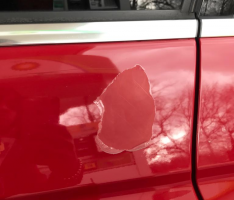
— A Mercedes red paint settlement has been granted final approval by a federal judge after car owners alleged their 590 Mars Red paint blistered, peeled and bubbled.
The red paint lawsuit settlement was reached after the automaker said it would be cheaper to settle the class action than continue to fight a prolonged court battle.
However, Mercedes-Benz says it denies all allegations of liability and wrongdoing.
Included in the red paint settlement are current and former lessees and owners of these Mercedes-Benz vehicles that were painted with Mars Red 590 paint.
- 2004-2015 Mercedes-Benz C-Class
- 2010-2015 Mercedes-Benz GLK-Class
- 2006-2007, 2009, 2014 Mercedes-Benz CLS-Class
- 2004-2009 Mercedes-Benz CLK-Class
- 2008, 2015, 2017 Mercedes-Benz S-Class
- 2004-2009, 2011-2017 Mercedes-Benz SL-Class
- 2005-2006, 2013-2014 Mercedes-Benz CL-Class
- 2014-2015 Mercedes-Benz SLS-Class
- 2005-2006, 2010-2017 Mercedes-Benz E-Class
- 2005, 2011-2017 Mercedes-Benz G-Class
- 2016-2018 Mercedes-Benz GT-Class
- 2017 Mercedes-Benz SLC-Class
- 2005-2016 Mercedes-Benz SLK-Class
- 2008 Mercedes-Benz Maybach 57
According to the class action lawsuit, paint that peels and flakes will cause rust and corrosion to the vehicle body which forces customers to spend thousands of dollars for paint jobs. But Mercedes allegedly concealed defects in the paint which caused the paint to bubble within years.
The owners also claim their vehicles have lost their values because of how ugly the vehicles appear with peeling red paint.
The Mercedes Red Paint Settlement Agreement
The Mars Red paint settlement provides for two types of possible benefits which include reimbursement for qualified past repairs, and also coverage for qualified future repairs.
"Qualified" repairs are limited to "refinishing of affected areas only" in accordance with a technical service bulletin that was issued to dealers years before the red paint lawsuit was filed.
A "qualified past repair" is one that occurred before the effective date of the red paint settlement and performed in accordance with TSB L198.00-P-058914, and may have been performed by either a Mercedes dealer or independent repair shop.
However, reimbursement for a repair done at an independent facility won't exceed 10% of what the same repair would have cost if performed at a dealership.
A "qualified future repair" relates to repainting a section because of bubbling, peeling or flaking of the exterior clear coat.
However, reimbursements for past repairs and coverage for future repairs are on a sliding scale based on the age and mileage of the vehicle. Considering some of the models are as old as 2004 model year, a customer may be stuck with partial reimbursements or required to pay part of the future paint job.
Objectors to the red paint settlement, including some plaintiffs from a separate Mercedes class action that was joined to the current action, argue the settlement does nothing about an alleged loss of vehicle values because of the paint defects.
Some objectors also complain Mercedes will still not be required to order a recall to fix the vehicles, but the judge overruled the objectors on all of their objections.
The attorneys representing Mercedes customers will receive an "award of $4,750,000.00, [and] reimbursement of $75,671.38 in expenses."
But according to the judge, the six Mercedes customers who sued will not receive the $5,000 each owner requested as an "incentive award."
Class action lawsuits may be filed by just one customer who typically receives an award as the plaintiff (class representative) if a settlement is granted final approval. In the case of the Mercedes red paint lawsuit, six customers are named as plaintiffs.
But Judge Mark H. Cohen ruled the six customers who filed the Mercedes red paint lawsuit will not receive $5,000 each or any other amount as an incentive.
His ruling is based on a recent case that referenced two cases from the 1800s.
According to the Mercedes red paint settlement, prior to September 17, 2020, courts routinely approved incentive awards to compensate class representatives.
But on that date, the U.S. Court of Appeals for the Eleventh Circuit made a decision in a case called Johnson v. NPAS Sols., in which the appeals court held, "[a] plaintiff suing on behalf of a class . . . cannot be paid a salary or be reimbursed for his personal expenses."
The Eleventh Circuit decision was based on two U.S. Supreme Court decisions, one from 1882 (Trustees v. Greenough), and one from 1885 (Cent. R.R. & Banking Co. v. Pettus).
The judge in the Mercedes case says the appeals court found that these two Supreme Court cases, "prohibit the type of incentive award that the district court approved here one that compensates a class representative for his time and rewards him for bringing a lawsuit."
Judge Cohen ruled he must follow the Eleventh Circuit decision regarding the six Mercedes plaintiffs and must deny their request for incentive awards. The six customers who sued may still be eligible to receive what all class members may receive from the settlement.
The Mercedes red paint lawsuit was filed in the U.S. District Court for the Northern District of Georgia: Pinon, et al., v. Daimler AG and Mercedes Benz USA, LLC.
The plaintiffs are represented by Heninger Garrison Davis, LLC, and Jackson & Tucker, P.C.
Read details about the Mercedes vehicle age and mileage limitations.




